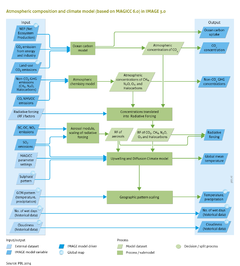Atmospheric composition and climate/Description: Difference between revisions
Jump to navigation
Jump to search
No edit summary |
No edit summary |
||
| Line 1: | Line 1: | ||
{{ComponentDescriptionTemplate | {{ComponentDescriptionTemplate | ||
|Reference=Forster et al., 2007; WMO/UNEP, 2013; Meinshausen et al., 2011a; Myhre et al., 2013; Denman et al., 2007; | |Reference=Forster et al., 2007; WMO/UNEP, 2013; Meinshausen et al., 2011a; Myhre et al., 2013; Denman et al., 2007; | ||
|Description====Atmospheric gas concentrations=== | |Description====Atmospheric gas concentrations=== | ||
The IMAGE climate model (based on [[MAGICC model|MAGICC 6.0]], [[Meinshausen et al., 2011a]]) calculates atmospheric CO2 concentration based on CO2 emission data for energy, industry and land-use change (Component[[Emissions]]); terrestrial carbon balance (Component [[Carbon cycle and natural vegetation]]); and carbon uptake by the oceans (calculated in MAGICC on the basis of the Bern Ocean Carbon model). | The IMAGE climate model (based on [[MAGICC model|MAGICC 6.0]], [[Meinshausen et al., 2011a]]) calculates atmospheric CO2 concentration based on CO2 emission data for energy, industry and land-use change (Component[[Emissions]]); terrestrial carbon balance (Component [[Carbon cycle and natural vegetation]]); and carbon uptake by the oceans (calculated in MAGICC on the basis of the Bern Ocean Carbon model). | ||
| Line 7: | Line 7: | ||
===Atmospheric energy balance=== | ===Atmospheric energy balance=== | ||
Change in atmospheric gas concentrations also changes the amount of radiation absorbed or transmitted by the atmosphere, and thus changes the earth’s energy balance and temperature. The energy balance change is expressed as radiative forcing per gas, measured in W/m2. In MAGICC, concentrations of long-lived greenhouse gases are translated into radiative forcing values using radiative efficiency estimates from the IPCC ([[Myhre | Change in atmospheric gas concentrations also changes the amount of radiation absorbed or transmitted by the atmosphere, and thus changes the earth’s energy balance and temperature. The energy balance change is expressed as radiative forcing per gas, measured in W/m2. In MAGICC, concentrations of long-lived greenhouse gases are translated into radiative forcing values using radiative efficiency estimates from the IPCC ([[Myhre et al., 2013]]), and radiative forcing of tropospheric ozone is calculated based on ozone sensitivity factors from MAGICC6.0 ([[Meinshausen et al., 2011a]]; [[Meinshausen et al., 2011b]]). | ||
However, other processes also lead to changes in the atmospheric energy balance, which are also modelled and assigned a radiative forcing value. Aerosols, such as SO2, NOx, and organic carbon, have a direct cooling effect by reflecting more radiation back into space (direct aerosol effect). They also interact with clouds and precipitation in many ways (indirect aerosol effect); this cloud feedback is the largest source of uncertainty in estimating climate sensitivity ([[Denman et al., 2007]]). Although also an aerosol, black carbon has a strong direct warming effect ([[WMO/UNEP, 2013]]). | However, other processes also lead to changes in the atmospheric energy balance, which are also modelled and assigned a radiative forcing value. Aerosols, such as SO2, NOx, and organic carbon, have a direct cooling effect by reflecting more radiation back into space (direct aerosol effect). They also interact with clouds and precipitation in many ways (indirect aerosol effect); this cloud feedback is the largest source of uncertainty in estimating climate sensitivity ([[Denman et al., 2007]]). Although also an aerosol, black carbon has a strong direct warming effect ([[WMO/UNEP, 2013]]). | ||
| Line 22: | Line 22: | ||
Grid-specific temperature and precipitation changes at the end of the century (2071–2100 compared to 1961–1990) from AR4 {{abbrTemplate|AOGCM}} model results ([[IPCC-DDC, 2007]]) are linearly interpolated based on the MAGGICs global mean temperature change at a certain time step, and the global mean temperature change corresponding to this map. For future calculations, the results of AR5 should be used to update the MAGICC parameterisation for all available AOGCMs, and to update the gridded patterns of climate change. | Grid-specific temperature and precipitation changes at the end of the century (2071–2100 compared to 1961–1990) from AR4 {{abbrTemplate|AOGCM}} model results ([[IPCC-DDC, 2007]]) are linearly interpolated based on the MAGGICs global mean temperature change at a certain time step, and the global mean temperature change corresponding to this map. For future calculations, the results of AR5 should be used to update the MAGICC parameterisation for all available AOGCMs, and to update the gridded patterns of climate change. | ||
}} | }} | ||
Revision as of 19:14, 20 May 2014
Parts of Atmospheric composition and climate/Description
| Component is implemented in: |
|
| Related IMAGE components |
| Projects/Applications |
| Models/Databases |
| Key publications |
| References |
